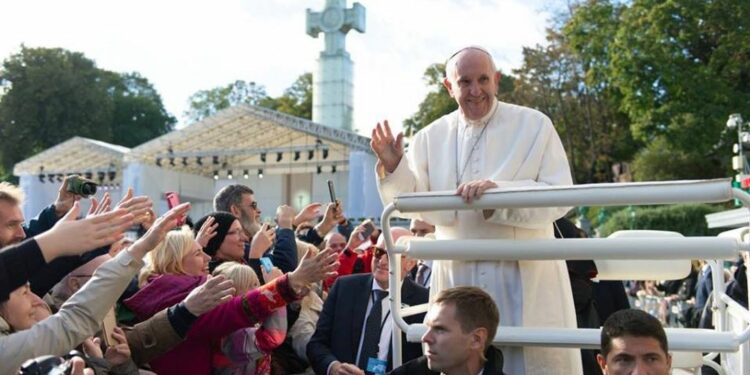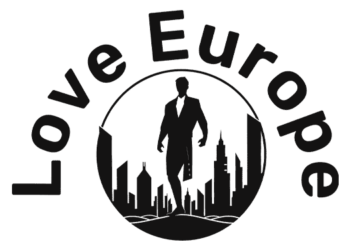On Sunday, December 29, as the Jubilee Year begins, not a single Catholic
parishioner in Tallinn, the Estonian capital hosting the 47th Taizé European
Meeting until January 1, wanted to miss the Estonian-language Mass at Sts.
Peter and Paul Cathedral. Many stood outside in the cold to follow the
service. The cathedral has become too small for this growing community. “We
have gone from a few transient Catholics at the end of the Soviet occupation in
1990 to a registered number that ranges between 8,000 and 10,000,” said Bishop
Philippe Jourdan of Tallinn.
In September, Pope Francis elevated the apostolic administration to a
diocese. For Bishop Jourdan, hailing from southwest France and now serves as Bishop
of Tallinn, this signifies that the Estonian Church has reached “a certain
maturity” and that the Vatican “trusts” it to develop independently.
One church, multiple communities
Jourdan, a graduate of one of France’s most prestigious engineering schools, recalled learning “construction Russian” during his studies,
knowledge that proved useful when he became vicar general of the Estonian
Apostolic Administration in 1996. Reflecting on his career, he jokes, “I didn’t
build many physical bridges,” but in Estonia, while accompanying the Catholic
Church, he has helped build “metaphorical ones between the two linguistic
communities” in a divided society. These divisions have deepened since the
war in Ukraine, particularly concerning the Russian-speaking minority.
Orthodox Christians, divided into two churches—one linked to the Moscow
Patriarchate and the other to Constantinople—make up nearly 15% of the
population. The Lutheran Church encompasses about 10% of Estonians in a highly
secularized country where roughly 70% claim no religion. Among the 0.8% who are
Catholics, there are “converted Estonians or children of converts, and Russian
speakers with Belarusian or Ukrainian roots,” explained Bishop Jourdan.
This diversity appealed to Margue-Marie Paas, 48, who joined the Catholic
Church 18 years ago. “I’ve met so many different people: Estonians, Russian
Catholics, and even foreign Catholics, who are increasingly moving to Estonia
to work in the tech sector.”
Though each community has its own language-specific Mass (in English,
Estonian, Russian, and Polish), “many Russian speakers attend the Estonian
Mass, and parishioners freely move between celebrations,” noted Natalia, in her
forties, after attending a Russian-language Mass. “Here, people are Christians
first, before being Russian or Estonian, guided by the same thirst for truth
and faith in God. Being part of the same faith community helps us to have fewer
stereotypes about one another.”
The War in Ukraine: A delicate issue
This bridge, built on shared devotion, is something Father Igor Gavrilchik
witnesses firsthand as he prepares young people for baptism. During the Taizé
European Meeting, the Russian-speaking priest coordinates a small team of
young Catholic volunteers, including Russian speakers. “They’re used to working
and praying together, which is very important for them,” he said.
How does the Catholic Church in Estonia experience the war in Ukraine?
Russia’s invasion, which began on Estonia’s Independence Day, has heightened
tensions. While praying for peace is uncontroversial, discussing Russia’s
aggression remains sensitive. “The community reflects Estonian society,”
admitted Bishop Jourdan, who has noticed a cooling of relations with
Russian-speaking Catholics.
“When I visit parishes in eastern Estonia, near the Russian border, I’m
advised to be particularly cautious,” he added. “We must accept that
mentalities differ while staying clear on our positions.” This delicate
balancing act is essential for maintaining dialogue, which benefits the entire
nation.
The Taizé meet
Poles, Ukrainians, Germans, French… More than 3,500 young people gathered December
28, to begin the 47th European Meeting of Taizé.
“Coming together in a spirit of sharing and fraternity is all the more important in today’s context when our world is going through serious difficulties,” Pope Francis noted in a message sent to the young people and the community’s brothers December 28. “Many countries are afflicted by violence and
war, many people are victims of inhumane treatment, and others are
disorientated by the inequalities in our societies and the ecological dangers.”
These pressing issues will be addressed during the meeting through moments
of prayer and workshops. Until January 1, the young participants will also have
the opportunity to engage in workshops focusing on Estonia’s cultural and
historical heritage, testimonies from young Ukrainians, ecumenism, and ecology.
Source link : http://www.bing.com/news/apiclick.aspx?ref=FexRss&aid=&tid=6773c785aad2451f9104924c6942bb20&url=https%3A%2F%2Finternational.la-croix.com%2Freligion%2Festonian-catholics-a-fragile-bridge-in-a-divided-society&c=1714803701363762729&mkt=de-de
Author :
Publish date : 2024-12-30 20:59:00
Copyright for syndicated content belongs to the linked Source.


